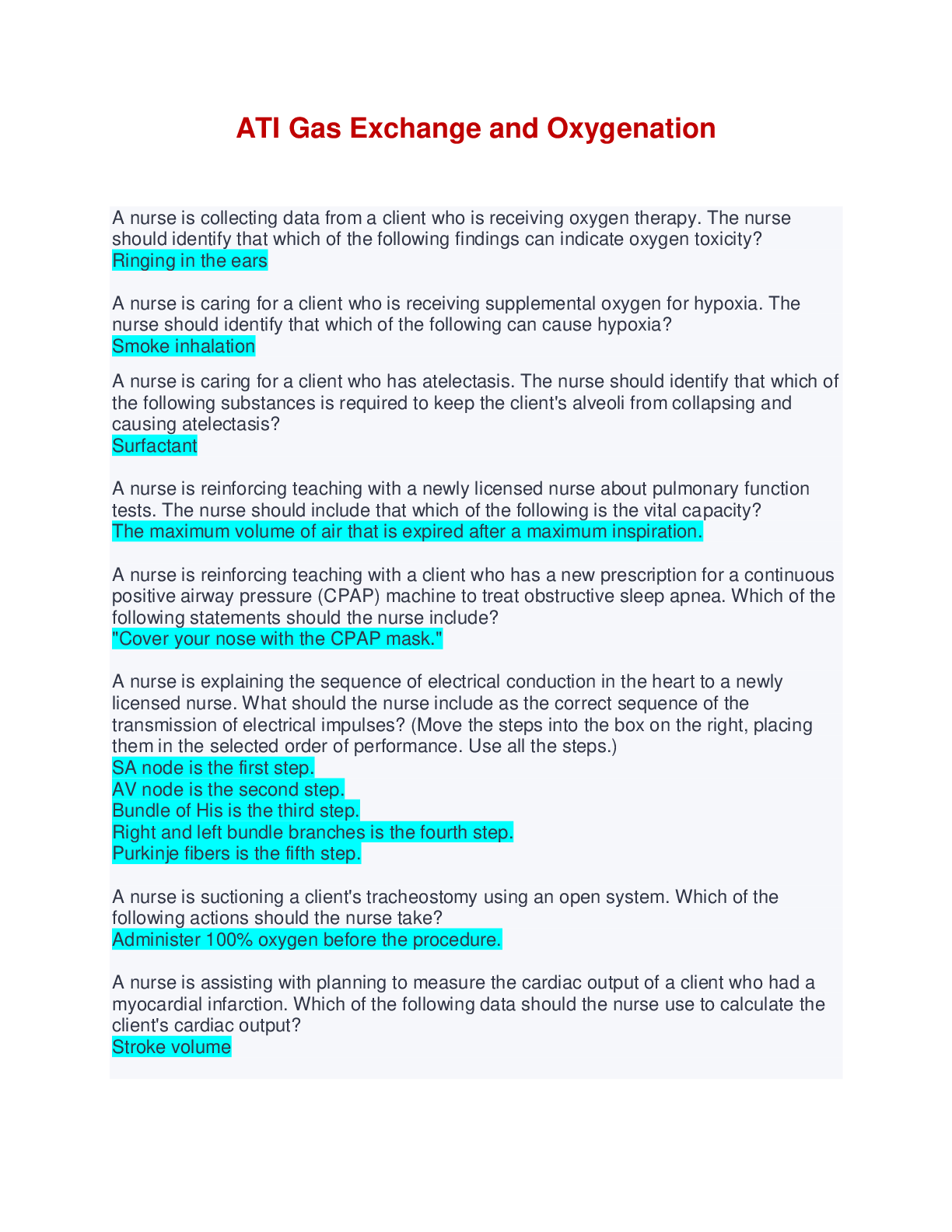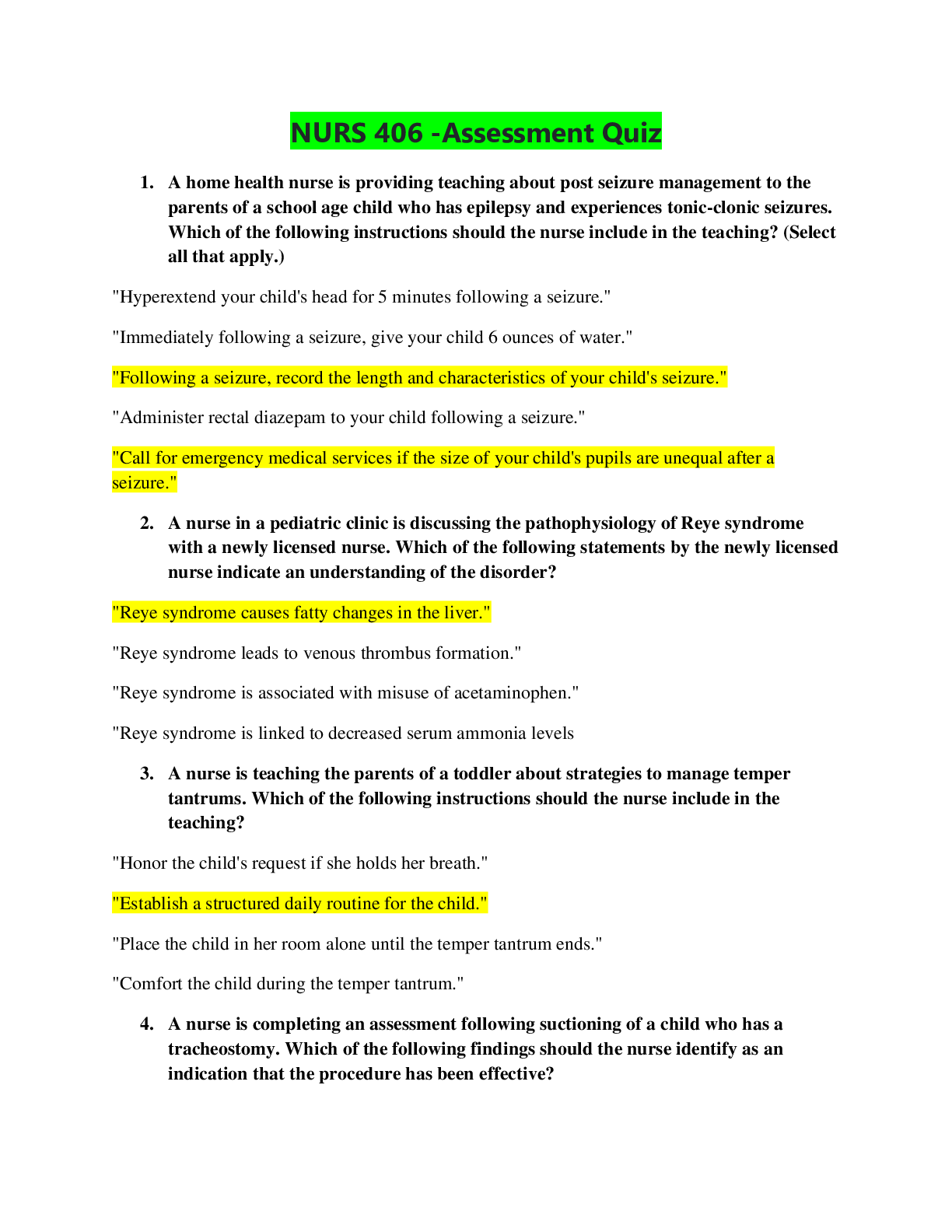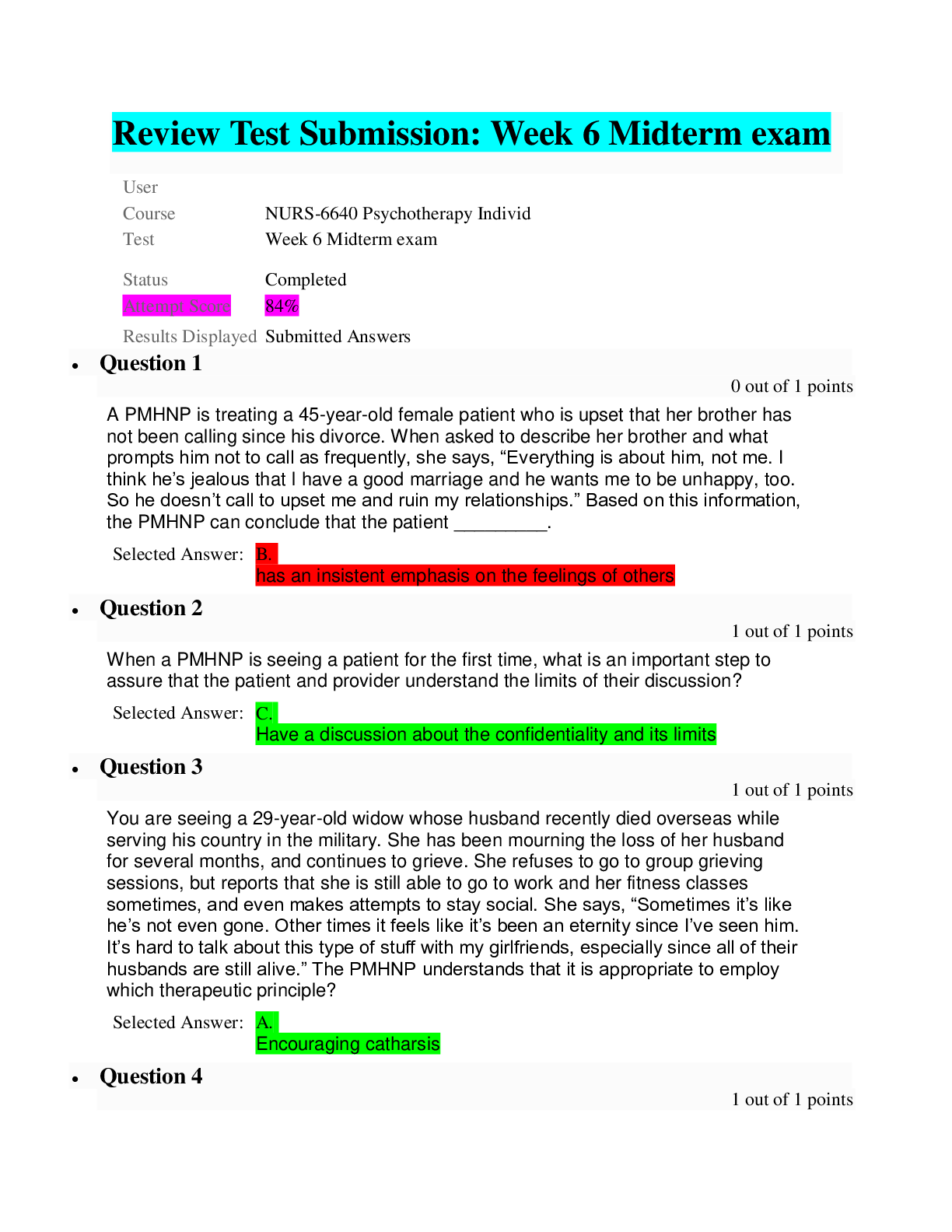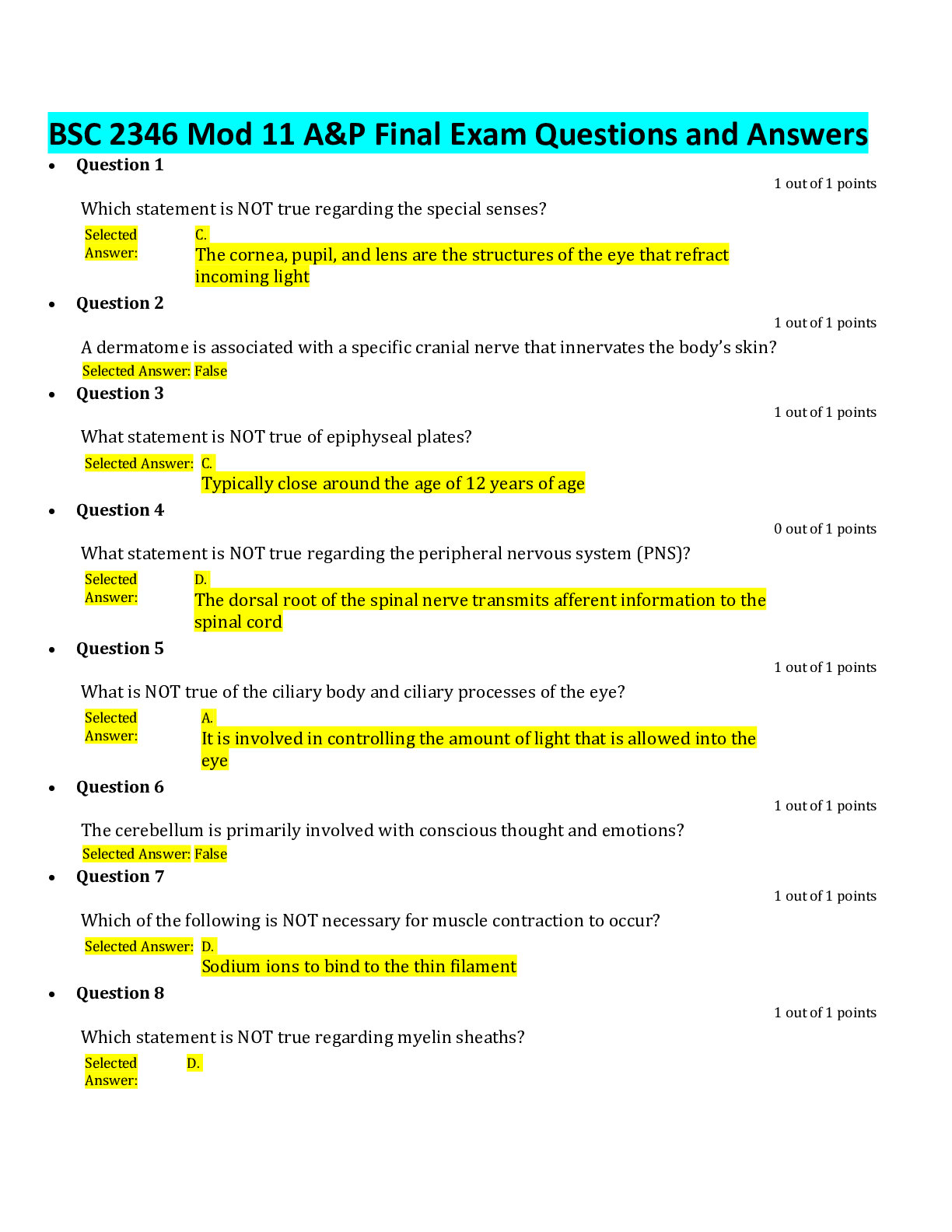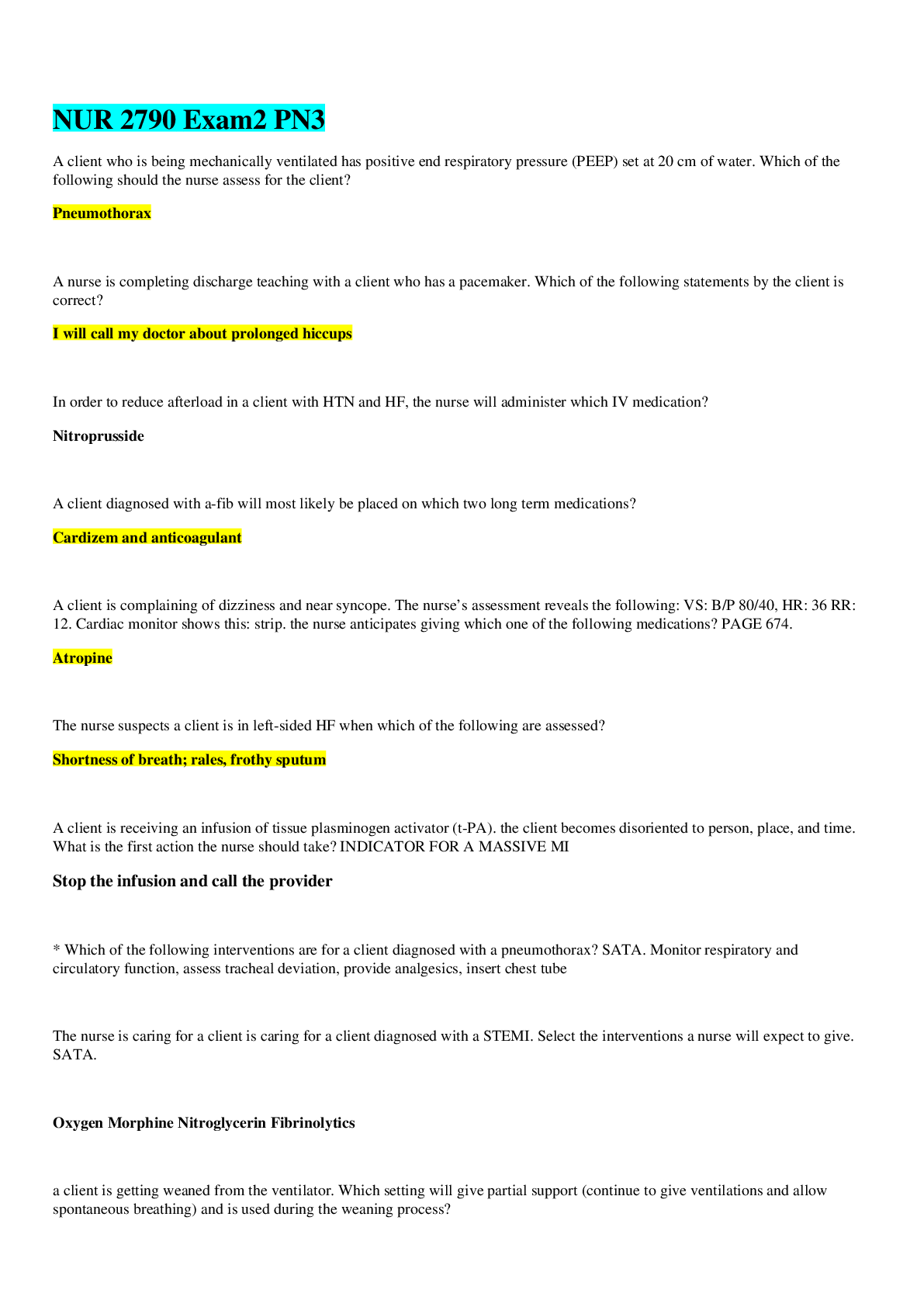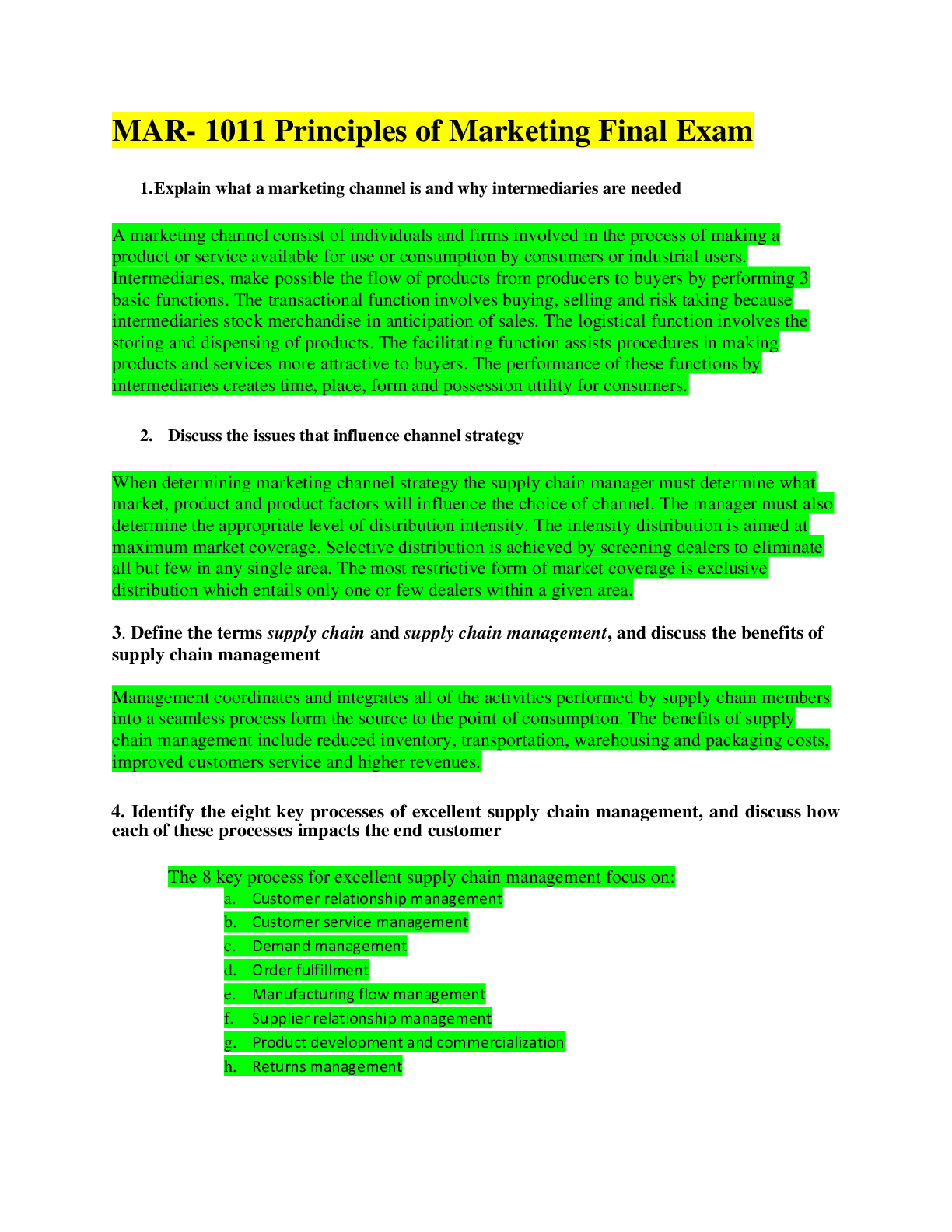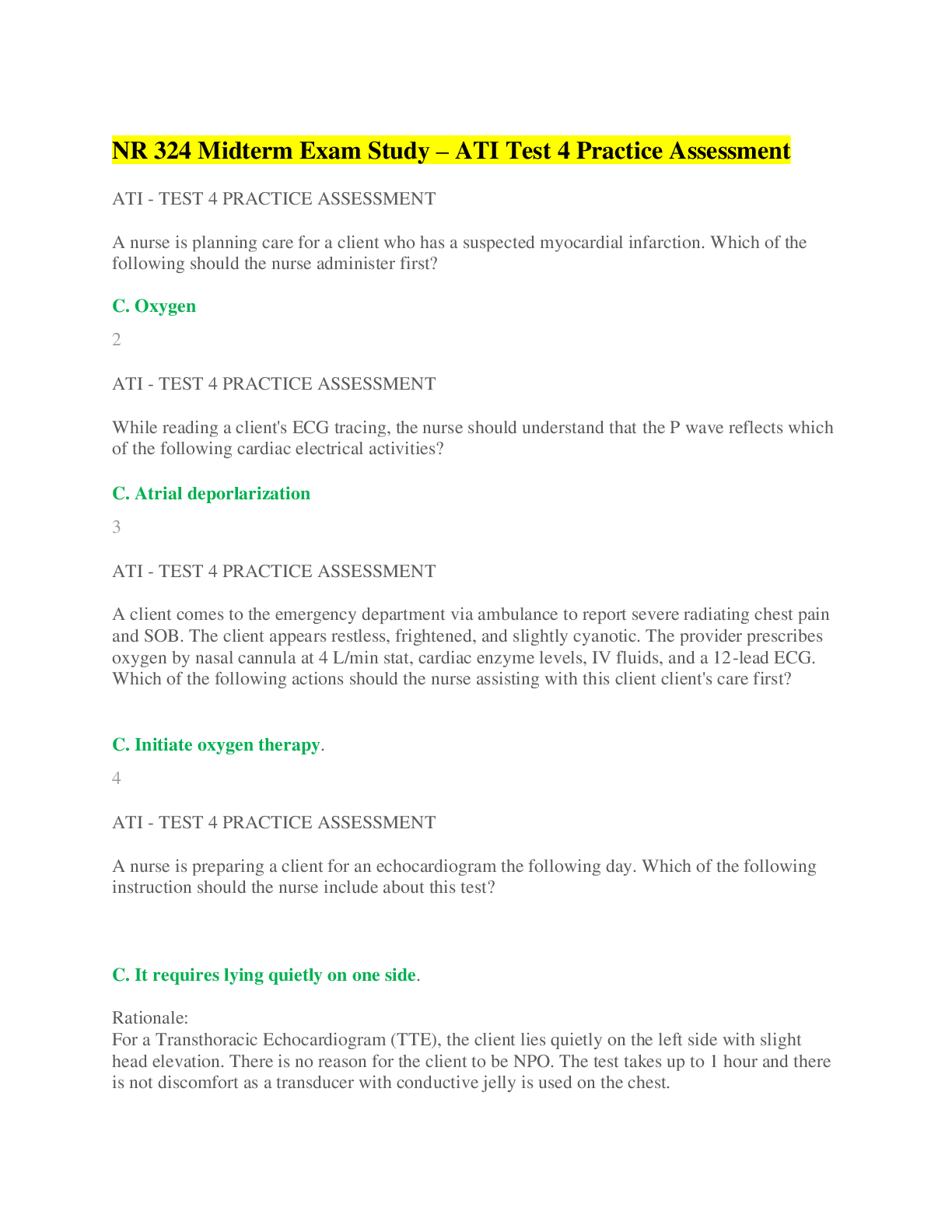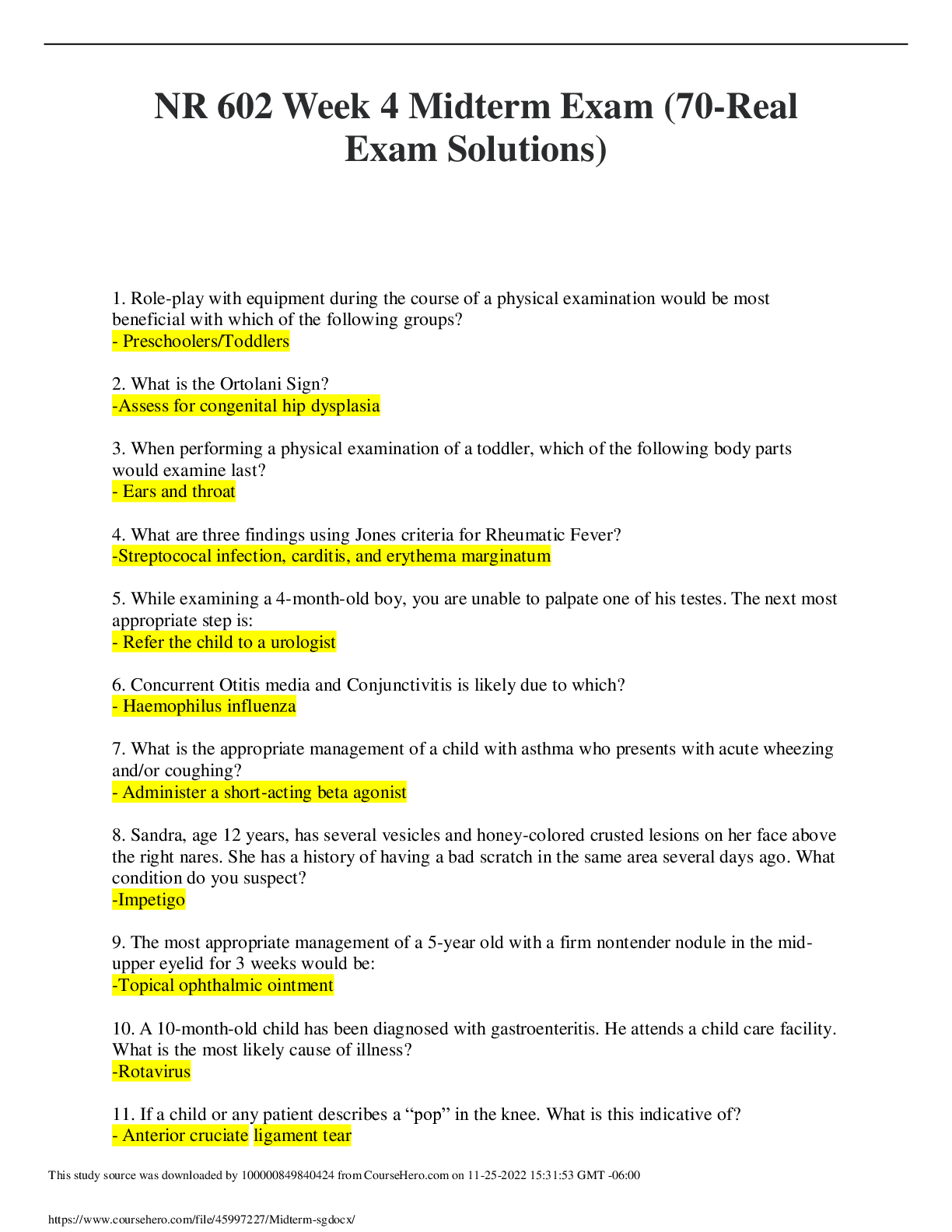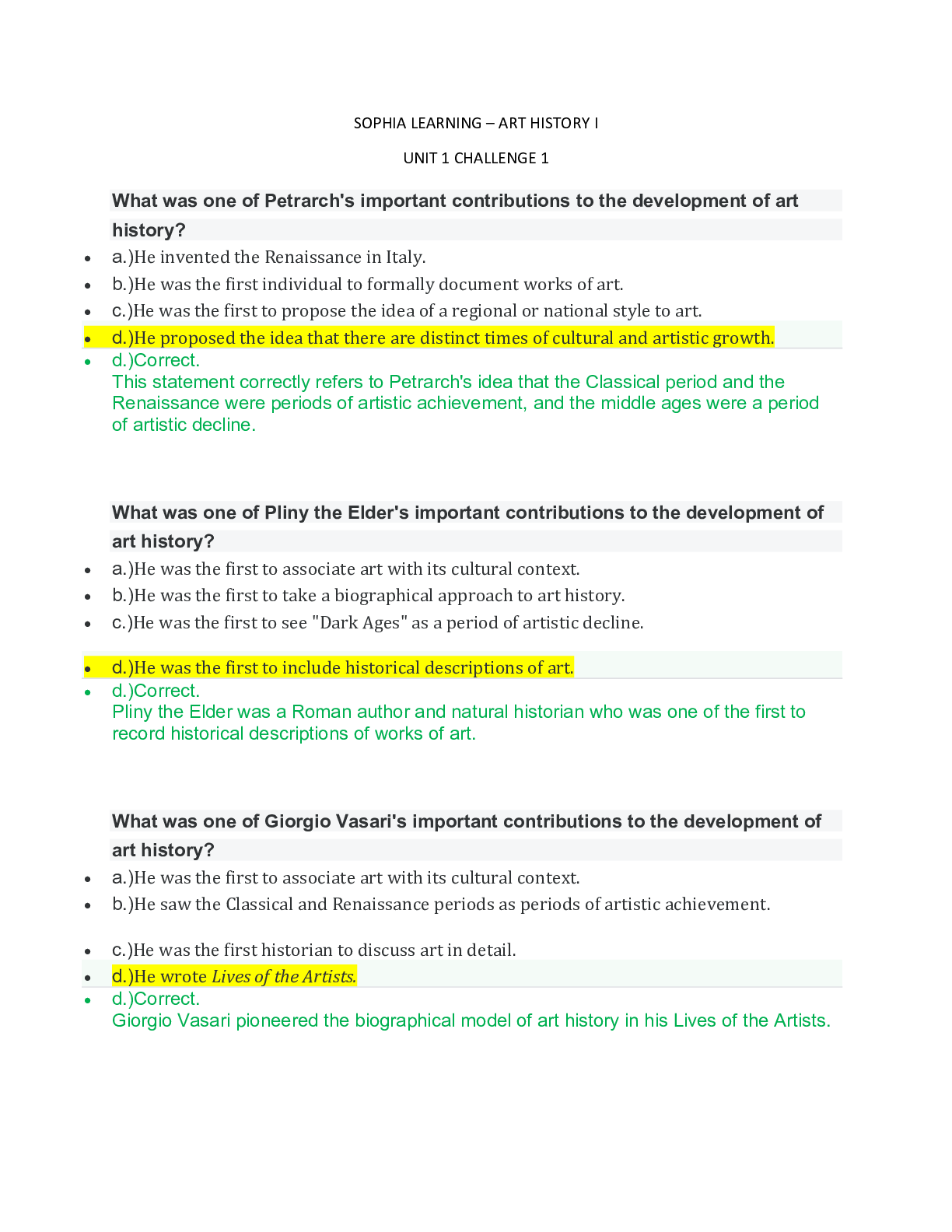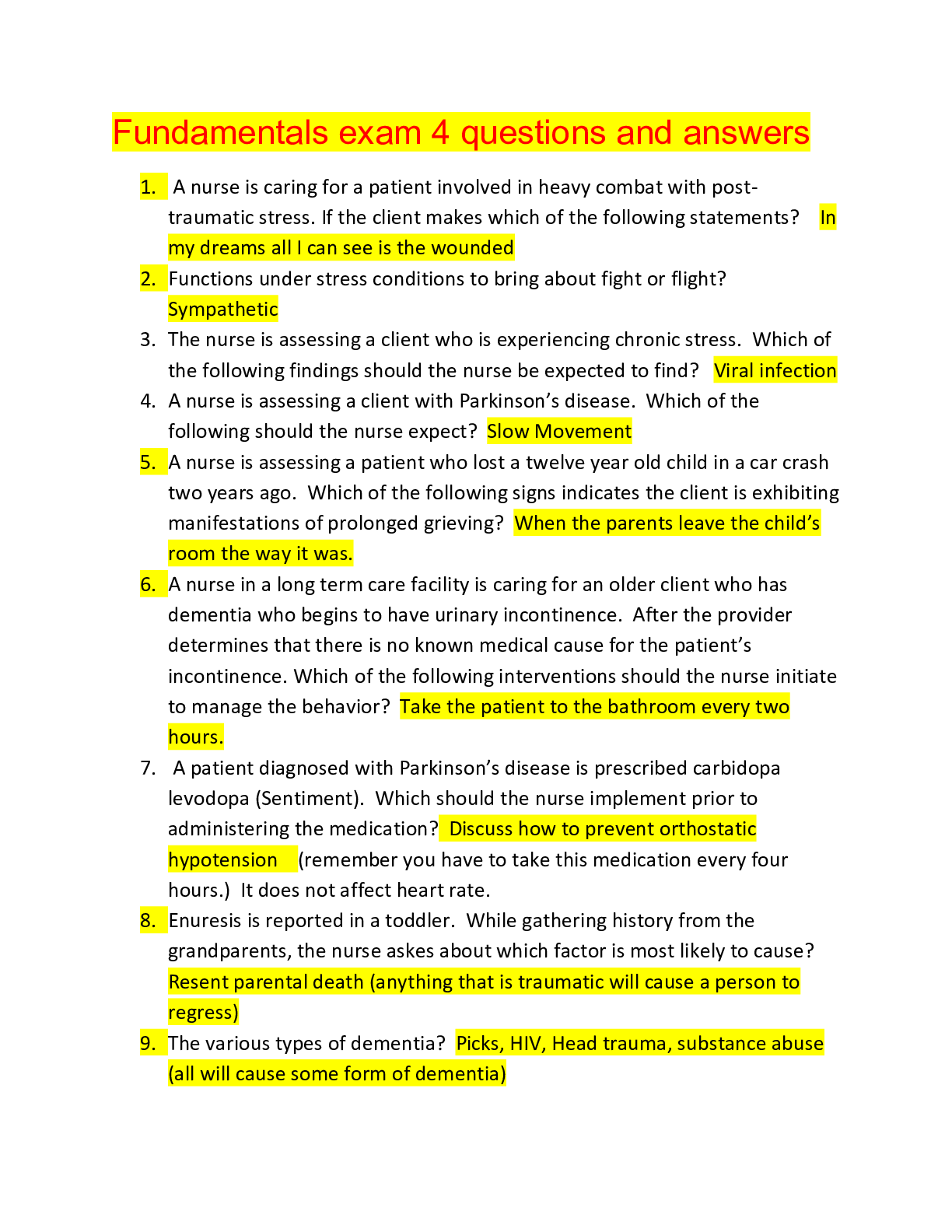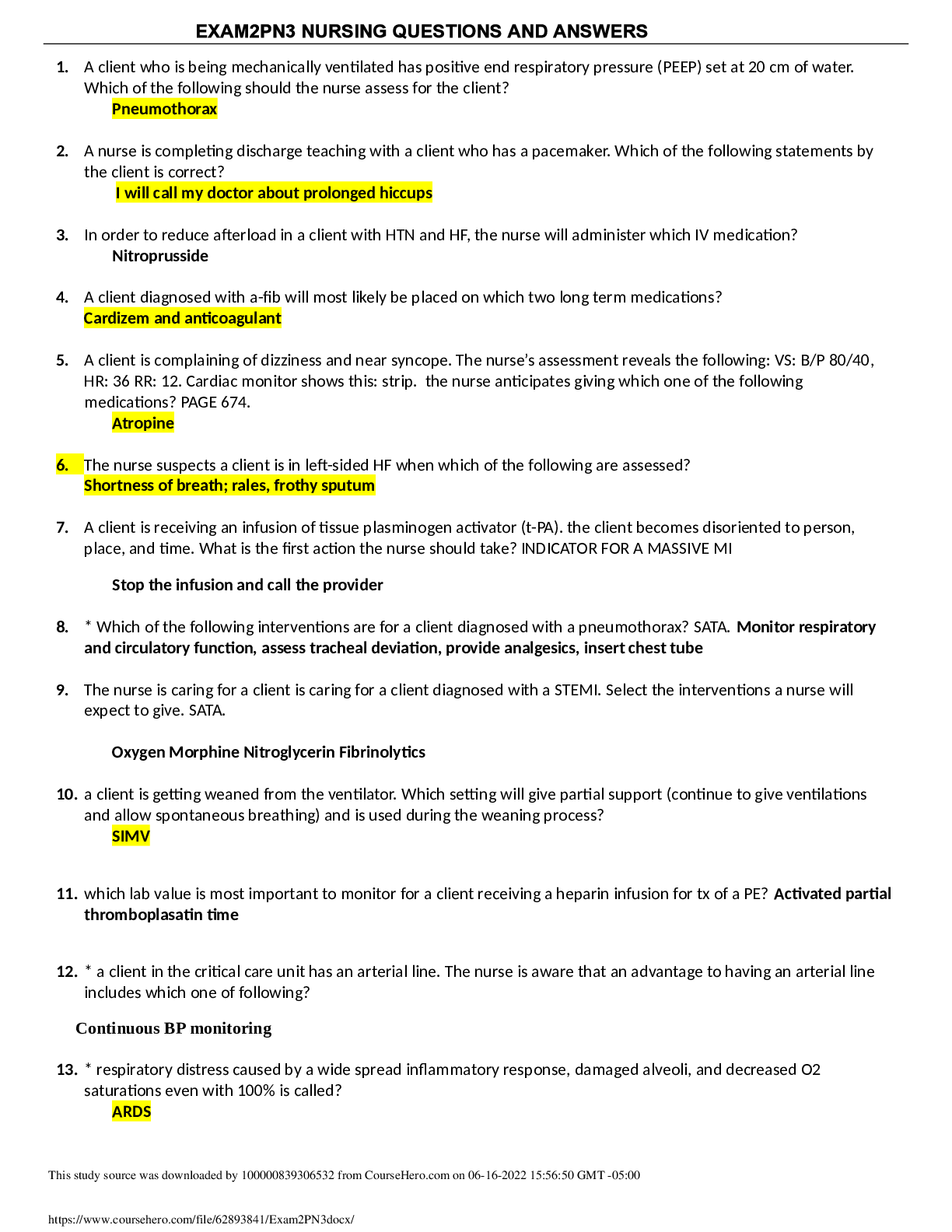NUR 2488 - Module 6 Ch 3, 11-14 Questions and Answers, 100% Correct
Document Content and Description Below
Module 6 Ch 3, 11-14 Chapter 3 Review Psychobiology and Psychopharmacology Questions 1. Besides antianxiety agents, which classification of drugs is also commonly given to treat anxiety and anxiet... y disorders? 2. What assessment question will provide the nurse with information regarding the effects of a woman’s circadian rhythms on her quality of life? 3. You realize that your patient who is being treated for a major depressive disorder requires more teaching when she makes the following statement: 4. A patient being treated for insomnia is prescribed ramel-teon (Rozerem). Which comorbid mental health condition would make this medication the hypnotic of choice for this particular patient? 5. Which statement made by a patient prescribed bupropion (Wellbutrin) demonstrates that the medication education the patient received was effective? Select all that apply. 6. Which drug group calls for nursing assessment for development of abnormal movement disorders among individuals who take therapeutic dosages? 7. A nurse reviews an order for a CYP450 test. He explains to his patient from Thailand that the test will determine how the antidepressant will be: 8. Psychotropic drugs have been used for more than half a century. What statement regarding their current status is true? 9. The nurse administers each of the following drugs to various patients. The patient who should be most carefully assessed for fluid and electrolyte imbalance is the one receiving: 10. A psychiatric nurse is reviewing prescriptions for a patient with major depression at the county clinic. Since the patient has a mild intellectual disability, the nurse would question which classification of antidepressant drugs: Chapter 11 Review Childhood and Neurodevelopmental Disorders Questions 1. Which statement demonstrates a well-structured attempt at limit setting? 2. Which activity is most appropriate for a child with ADHD? 3. Cognitive-behavioral therapy is going well when a 12-year- old patient in therapy reports to the nurse practitioner: 4. What assessment question should the nurse ask when attempting to determine a teenager’s mental health resilience? Select all that apply. 5. Which factors tend to increase the difficulty of diagnosing young children who demonstrate behaviors associated with mental illness? Select all that apply. 6. Pam, the nurse educator, is teaching a new nurse about seclusion and restraint. Order the following interventions from least (1) to most (5) restrictive: 7. In pediatric mental health there is a lack of sufficient numbers of community-based resources and providers, and there are long waiting lists for services. This has resulted in: Select all that apply. 8. Child protective services have removed 10-year-old Christopher from his parents’ home due to neglect. Christopher reveals to the nurse that he considers the woman next door his “nice” mom, that he loves school, and gets above average grades. The strongest explanation of this response is: 9. April, a 10-year-old admitted to inpatient pediatric care, has been getting more and more wound up and is losing self-control in the day room. Time-out does not appear to be an effective tool for April to engage in self-reflection. April’s mother admits to putting her in time-out up to 20 times a day. The nurse recognizes that: 10. Adolescents often display fluctuations in mood along with undeveloped emotional regulation and poor tolerance for frustration. Emotional and behavioral control usually increases over the course of adolescence due to: Chapter 12 Review Schizophrenia Spectrum Disorders Questions 1. Which characteristic in an adolescent female is sometimes associated with the prodromal phase of schizophrenia? 2. Which nursing intervention is particularly well chosen for addressing a population at high risk for developing schizophrenia? 3. To provide effective care for the patient diagnosed with schizophrenia, the nurse should frequently assess for which associated condition? Select all that apply. 4. A female patient diagnosed with schizophrenia has been prescribed a first-generation antipsychotic medication. What information should the nurse provide to the patient regarding her signs and symptoms? 5. Which characteristic presents the greatest risk for injury to others by the patient diagnosed with schizophrenia? 6. Gilbert, age 19, is described by his parents as a “moody child” with an onset of odd behavior about at age 14, which caused Gilbert to suffer academically and socially. Gilbert has lost the ability to complete household chores, is reluctant to leave the house, and is obsessed with the locks on the windows and doors. Due to Gilbert’s early and slow onset of what is now recognized as schizophrenia, his prognosis is considered: 7. Which therapeutic communication statement might a psychiatric-mental health registered nurse use when a patient’s nursing diagnosis is altered thought processes? 8. When patients diagnosed with schizophrenia suffer from anosognosia, they often refuse medication, believing that: 9. Kyle, a patient with schizophrenia, began to take the first-generation antipsychotic haloperidol (Haldol) last week. One day you find him sitting very stiffly and not moving. He is diaphoretic, and when you ask if he is okay he seems unable to respond verbally. His vital signs are: BP 170/100, P 110, T 104.2°F. What is the priority nursing intervention? Select all that apply. 10. Tomas is a 21-year-old male with a recent diagnosis of schizophrenia. Tomas’s nurse recognizes that self-medicating with excessive alcohol is common in this disease and can co-occur along with: Chapter 13 Review Bipolar and Related Disorders Questions 1. Which nursing response demonstrates accurate information that should be discussed with the female patient diagnosed with bipolar and her support system? Select all that apply. 2. Which statement made by the patient demonstrates an understanding of the effective use of newly prescribed lithium to manage bipolar mania? Select all that apply. 3. The nurse is providing medication education to a patient who has been prescribed lithium to stabilize mood. Which early signs and symptoms of toxicity should the nurse stress to the patient? Select all that apply. 4. A male patient calls to tell the nurse that his monthly lithium level is 1.7 mEq/L. Which nursing intervention will the nurse implement initially? 5. Which intervention should the nurse implement when caring for a patient demonstrating manic behavior? Select all that apply. 6. Substance abuse is often present in people diagnosed with bipolar disorder. Laura, a 28-year-old with a diagnosis of bipolar disorder, drinks alcohol instead of taking her prescribed medications. The nurse caring for this patient recognizes that: 7. Ted, a former executive, is now unemployed due to manic episodes at work. He was diagnosed with bipolar I 8 years ago. Ted has a history of IV drug abuse, which resulted in hepatitis C. He is taking his lithium exactly as scheduled, a fact that both Ted’s wife and his blood tests confirm. To reduce Ted’s mania the psychiatric nurse practitioner recommends: 8. A 33-year-old female diagnosed with bipolar I disorder has been functioning well on lithium for 11 months. At her most recent checkup, the psychiatric nurse practitioner states, “You are ready to enter the maintenance therapy stage, so at this time I am going to adjust your dosage by prescribing”: 9. Tatiana has been hospitalized for an acute manic episode. On admission the nurse suspects lithium toxicity. What assessment findings would indicate the nurse’s suspicion as correct? 10. Luc’s family comes home one evening to find him extremely agitated and they suspect in a full manic episode. The family calls emergency medical services. While one medic is talking with Luc and his family, the other medic is counting something on his desk. What is the medic most likely counting? Chapter 14 Review Depressive Disorders Questions 1. Which response by a 15-year-old demonstrates a common symptom observed in patients diagnosed with major depressive disorder? 2. Which assessment question asked by the nurse demonstrates an understanding of comorbid mental health conditions associated with major depressive disorder? Select all that apply. 3. Which nursing intervention focuses on managing a common characteristic of major depressive disorder associated with the older population? 4. Which characteristic identified during an assessment serves to support a diagnosis of disruptive mood dysregulation disorder? Select all that apply. 5. Which chronic medical condition is a common trigger for major depressive disorder? 6. Tammy, a 28-year-old with major depressive disorder and bulimia nervosa, is ready for discharge from the county hospital after 2 weeks of inpatient therapy. Tammy is taking citalopram (Celexa) and reports that it has made her feel more hopeful. With a secondary diagnosis of bulimia nervosa, what is an alternative antidepressant to consider? 7. Cabot has multiple symptoms of depression including mood reactivity, social phobia, anxiety, and overeating. With a history of mild hypertension, which classification of antidepressants dispensed as a transdermal patch would be a safe medication? 8. When a nurse uses therapeutic communication with a withdrawn patient who has major depression, an effective method of managing the silence is to: 9. The biological approach to treating depression with electrodes surgically implanted into specific areas of the brain to stimulate the regions identified to be underactive in depression is: 10. Two months ago, Natasha’s husband died suddenly and she has been overwhelmed with grief. When Natasha is subsequently diagnosed with major depressive disorder, her daughter, Nadia, makes which true statement? [Show More]
Last updated: 1 year ago
Preview 1 out of 8 pages
Instant download
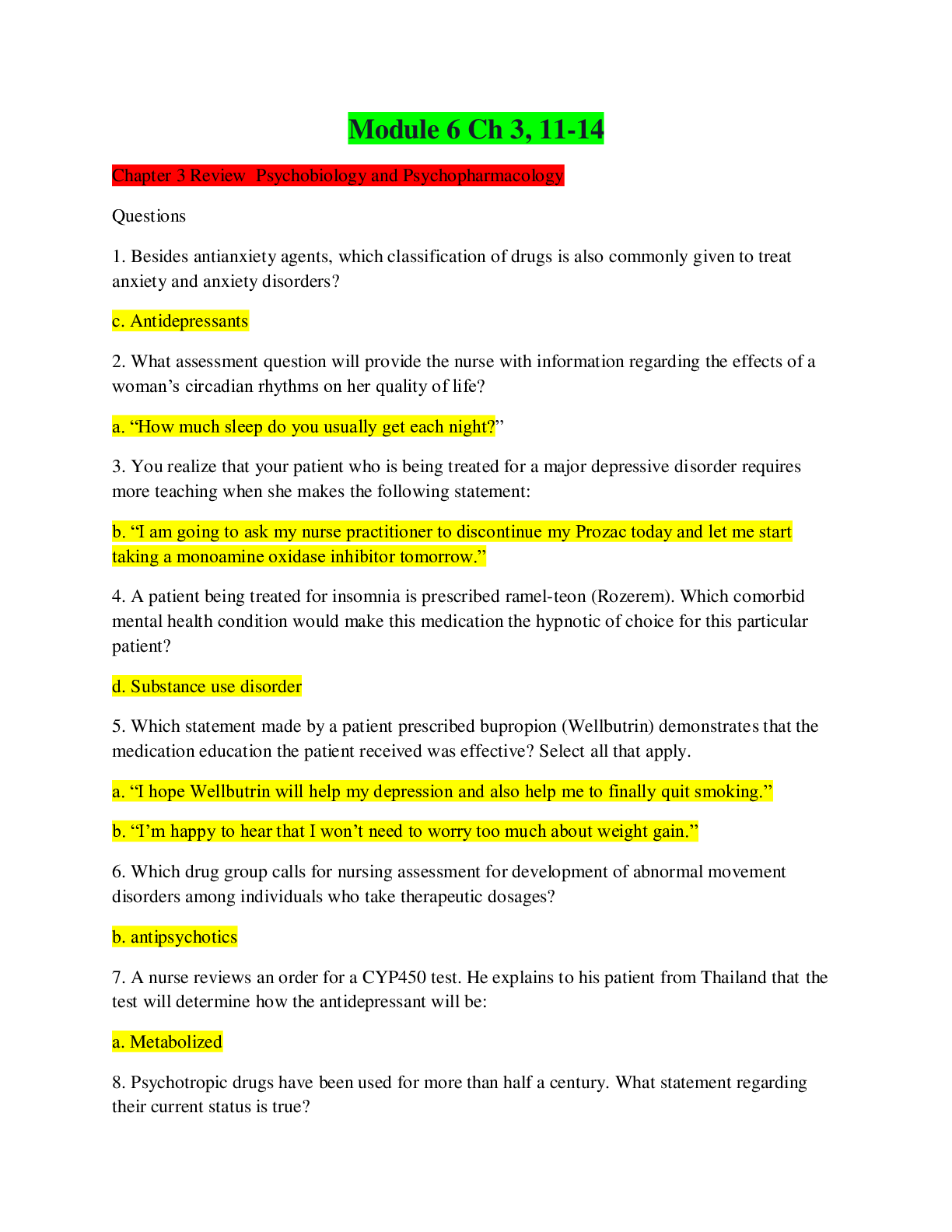
Buy this document to get the full access instantly
Instant Download Access after purchase
Add to cartInstant download
Reviews( 0 )
Document information
Connected school, study & course
About the document
Uploaded On
Jan 25, 2021
Number of pages
8
Written in
Additional information
This document has been written for:
Uploaded
Jan 25, 2021
Downloads
0
Views
37


